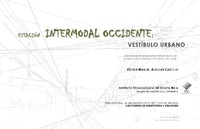Mostrar el registro sencillo del ítem
Estación intermodal occidente
| dc.contributor.advisor | William Monge Quesada | es |
| dc.contributor.author | Aguilar-Castillo, Víctor Manuel | |
| dc.date.accessioned | 2020-06-18T20:20:15Z | |
| dc.date.available | 2020-06-18T20:20:15Z | |
| dc.date.issued | 2010 | |
| dc.identifier.uri | https://hdl.handle.net/2238/11433 | |
| dc.description | Proyecto de graduación (Licenciatura en Arquitectura y Urbanismo) Instituto Tecnológico de Costa Rica, Escuela de Arquitectura y Urbanismo, 2010. | es |
| dc.description.abstract | As in the smallest cities as in the largest cities in the world, the urban mobility constitutes a big challenge; and it must facilitate the progress in the urban centers and represent a key factor for its planning and renewal; position that it is constituted by both nowadays, and the living environment of the most majority of the population. Against this background, the present graduation work shows the process and the development of the INTERMODAL OCCIDENT STATION, considered one of the scope proposed as a complementary and necessary for the Mata Redonda zone and the Hospital. Which complements the regeneration of the sector plan, it is from the rail axis which is provided by the PRUGAM Project and contemplated within the National Urban Development Plan (PNDU). The main objective of this work is to generate the Intermodal Station project, which is contemplated in the Integrated Public Transportation System (SITP); replacing the bus stops and bus stations in the Coca Cola Market surroundings and by the Merced Park, to a great bus station located in the government terrains and by the local government too. Iit is developed in the central west sector of the Josephine town, route that goes from the Sabana to the Mayoreo Market. This project promotes the regeneration of the city. To achieve it, an analysis is made in the urban site, watching the urban structure and the functional space; the systems and the urban fabric that defines the parameters and the guidelines for the urban architectural design of the station. Finally, we present an appropriate design to the context. The dynamic space of cultural exchanges, as recreational, commercial, residential and service which links the rail axis of the Metropolitan Electric Train (TREM) with the development of Mata Redonda zone and Hospital in holistic, comprehensive and dynamic way. Articulating the different flows that surround and converge in the south and east sides of the Metropolitan Park La Sabana to the urban fabric, creating a public space for the rescue and enjoyment of the residents and visitors of the city, in order to satisfy the actual and future needs of the users of the public integrated transportation. | es |
| dc.description.sponsorship | Instituto Tecnológico de Costa Rica. Escuela de Arquitectura y Urbanismo. | es |
| dc.language.iso | spa | es |
| dc.publisher | Instituto Tecnológico de Costa Rica. | es |
| dc.rights | acceso abierto | es |
| dc.subject | Arquitectura | es |
| dc.subject | Transporte público | es |
| dc.subject | Diseño urbano | es |
| dc.subject | Planificación urbana | es |
| dc.subject | Diseño arquitectónico | es |
| dc.subject | Urbanismo | es |
| dc.title | Estación intermodal occidente | es |
| dc.title.alternative | vestíbulo urbano, regeneración urbanoarquitectónica en los distritos Mata Redonda y Hospital, San José | es |
| dc.type | proyecto fin de carrera | es |


